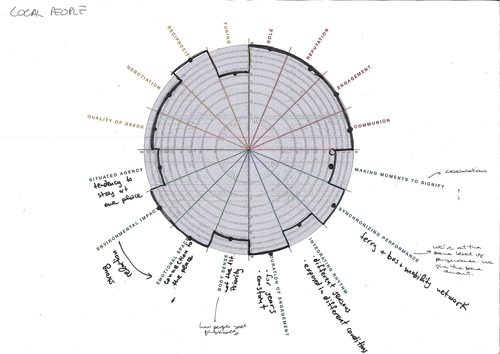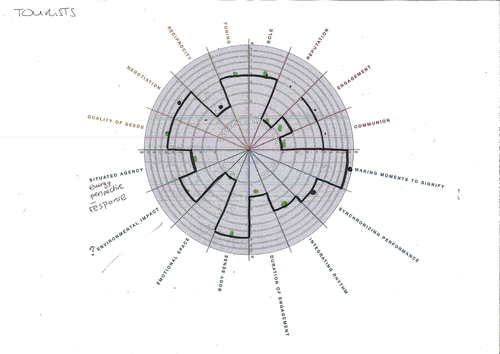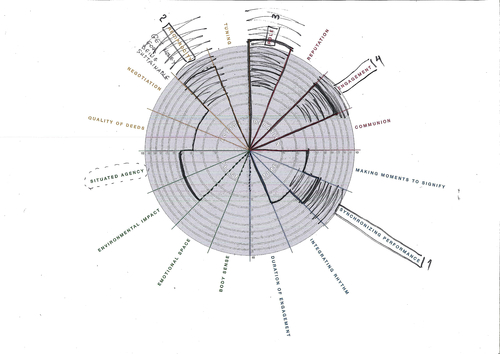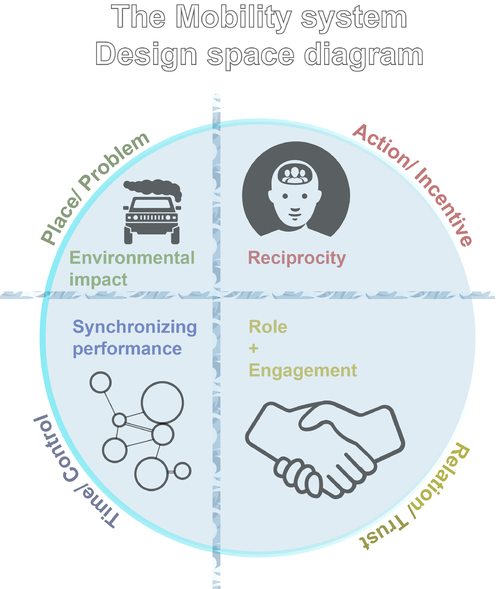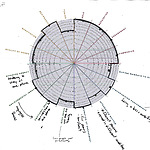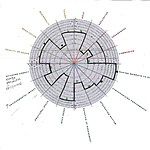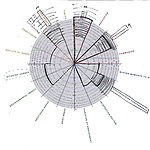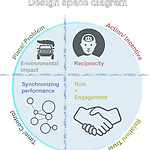In the line of designing for presence, the YUTPA analysis is a useful tool to determine subjective behaviours and opinions of different stakeholders towards a shared system. YUTPA stands for You in Unity of Time and Presence and the tool collects the values given by the different actors on these fields of the system according to their perceptions. When putting together the different perspectives, the discrepancies in how the different actors perceive the system are seen and from this, a design space can be elaborated.
• YUTPA Analysis for locals on the island
(Figure: YUTPA Diagram for locals)
As it can easily be derived by a short analysis of a person’s behaviour, the time that you are engaged with a place affects your relation and action within the society and the certain aspects of it.
The relation of the locals with the community in which they live and consequently interact is of a great importance for them. Especially in relevantly small societies, like Texel, where nature is the predominant characteristic and the population is distributed in small villages. Texelars have been engaged to this beautiful land, for quite some time (potentially their whole life), and consequently, they have an active role within the sociotechnical system. However, personal ambitions and interests affect the role of the different people that live and work in the same system. ( In the mobility system, this can be observed in the dramatic increase in the use of private cars by workers. ) Next to engagement, reputation is important for the locals’ consideration, as well as the existence of a well-structured communion. Engagement is the ethic value that keeps a society together and, therefore, the field to work on, aiming to build the desirable trust.
The time needed for the locals to be transported from their one point of interest to the other is really important, as it affects the quality of daily life and the combination of different activities managed. The use of private cars seems to be unavoidable for the locals, as the comfort provided by this mobile transport is incomparably higher than that of the public transport. For the field of synchronizing performance, it is understood how important the improvement of the synchronization between the different public mobile transports would be (therefore the score is very high). This is also because of the changes in the rhythm of daily life, through the different seasons, that definitely affect locals’ life, especially during the touristic period, with the population increase. Then the mobility system is highly used and therefore it has to be sustainable also from the aspect of comfort for the locals.
As for the place, the environmental impact of the use of the mobility system, especially during the high touristic seasons, is significant. The fact that, the locals experience really all this impact, as it affects both their emotional space and their well being, is something to be considered.
To close up, the action that a local can take within the communion, the possibility for discussion, within an adaptable system, that also provides its citizens with incentives, are parameters that speak to every local’s mind. Especially for the mobility aspect, as the mobile transport is a matter of personal choice, every person can contribute in the development of sustainable mobility in Texel. It is not only about creating new infrastructures. It is mainly about changing the established habits.
• YUTPA Analysis for tourists
(Figure: YUTPA Diagram for tourists)
On the other hand, the perspective of the tourist appears to be different. As the engagement to the place is not strong, the relation with it is not strong and also with the communion. Therefore, the tourist usually has less conscious about its role on the certain aspects, such as the behaviour concerning the use of mobile transport. What matters the most is the personal priorities of the tourist. That is the reason why the number of cars is increased so highly during the touristic periods.
Furthermore, what really matters about the tourist is the significant moments to be experienced within the vacation period and the sense of well being. In addition to this, the environmental impact of the mobility systems, in general, is a matter that people are constantly being informed about and its importance has started to be established.
• The Design Space for presence – Aspects to elaborate in Texel Mobility Systems
The design space created within these four quarters of relation, time place and action for the aspect of mobility has as following: The engagement both of locals and tourists with the place of Texel appears to be the driving force that potentially could change the role of the actors within that environment. Therefore, increasing the engagement of the actors with the environment where they act could be the initial step for redefining also their role as users of a more sustainable mobility system. The possible actions taken (and the benefits that could have for the actors), the time-frame where these can be integrated, and the environmental improvement that the total plan will bring set also the guidelines for the design space, inspired by the YUTPA analysis. Even if the environmental impact does not score high, especially for the tourists, it should be the main core for the development of a sustainable mobility system. It is an aspect of a great significance in order to understand in which ways the mobility system could be more sustainable and as this is mainly the aspect that will prove the level of sustainability of the implemented mobility system by 2060.
• The aspects with the most focus and why: Engagement, Synchronizing performance, etc.
(Illustration by Evgenia Kanli, using icons by the noun project website)
Within these boundaries, what looks appealing is to develop the synchronizing performance aspect, aiming in improving the comfort in mobile transportation for locals and tourists, decreasing this way the use of private car and in the same time the environmental impact of the mobility system. This basically means to create ideal connection between the different mobile transports within the island (Ferry, bus, bicycle and sharing of private cars) in terms of time. Additionally, this does not mean only to develop a solid, functional mobility system, but also to make this piece of information available, anytime, for all the possible users (via internet and relevant applications). Moreover, as it is aforementioned, raising the engagement with the place both the locals and the tourists and creating incentives that will create the proper environment for reciprocity to be developed, are parameters that can potentially contribute in the success of the sustainable mobility system that will be designed.
